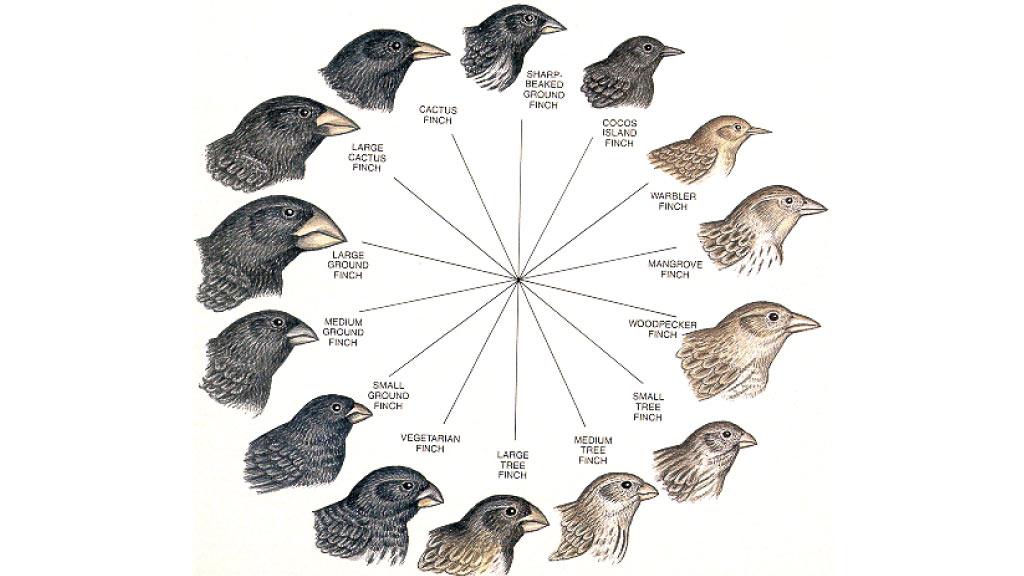What Statement Best Describes the Thirteen Different Finch Species
Galapagos finches also known as Darwin Finches are a key piece of Darwins theory of evolution by natural selection and are one of the most iconic animals in the Galapagos Archipelago. The warbler finch is the oldest species and the small ground finch is the most recent species to evolve Answer.

Evolution Evidence How Natural Selection Works Organizing From Kingdom Species Ppt Download
The population of hawks will increase.

. Which of the following statements best explains why many different finch species originated from the single ancestral species. The Galapagos Islands contain thirteen species of finches. All the Galápagos finches are more closely related to one another than they are to mainland finch species.
Which of the following statements best explains why many different finch species originated from the single ancestral species. Genetically there are four distinct lineages but the 13 species are currently classified among three genera. All of Darwins Finches are sparrow sized and similar in appearance with grey brown black or olive feathers.
Four are seen here. C all feed on the same diet in the Galápagos Islands. The galapagos islands contain thirteen species of finches.
A evolved in South America and flew to the Galápagos Islands. The Making of the Fittest. Individuals acquired unique characteristics during their lifetimes.
The 13 finch species evolved in sequencethe warbler finch is the oldest species and the small ground finch is the most recent species to evolve. The various Galápagos finch species. Natural Selection and Adaptation.
Which statement best describes a component of the original cell theory that was removed becaused of. Many years ago a small population of a single bird species migrated to the islands and evolved into the 13 species that live on the islands today. Four are seen here.
The warbler finch is the oldest species and the small ground finch is the most recent species to evolve. The population of foxes will increase. The 13 finch species evolved in sequence.
He later observed that the birds were similar in. Correct answer to the question The galapagos islands contain thirteen species of finches. Many years ago a small population of a single finch species migrated to the islands and evolved into the current 13.
It is believed that all of these species had one common ancestor and over time the species evolved. Natural Selection and Adaptation The Making of the Fittest. The current 13 finch species are the only species that survived.
The scientific theory of evolution is supported by different types of evidence. Genetically there are four distinct lineages but the thirteen species are currently classified among three genera. Its not clear based on the DNA evidence whether the 13 species arose from a single migration of one species or multiple migrations of several species from the mainland to the islands.
The diagram below shows many finch species that originated from a single ancestral finch species in the Galápagos Islands. Asked Sep 13 2016 in Environmental Atmospheric Sciences by Aisha92. Many years ago several different species of birds migrated to the islands and the 13 finch species that currently live there are the only species that survived.
Four are seen here. Which statement best describes what will happen if the population of herbivores in the community decreases. Darwins Finches are very fearless and very noisy.
About 13 different species of finches inhabit the Galápagos Islands today all descendants of a common ancestor from the South American mainland that arrived a few million years ago. B they all live on different islands. A they are not able to interbreed.
There are very few physical differences between the 13 or 14 species of Darwin Finch a reminder of the birds common origin. Scientists think that the whale evolved from the Ambulocetus. Charles Darwin collected over thirteen different species of a type of bird called a finch.
Many years ago a small population of a single bird species migrated to the islands and evolved into the 13 species that live on the islands today. Many years ago several different species of birds migrated to the islands and the 13 finch species that currently live there are the only species that survived. It is believed that all of these species had one common ancestor and over time the species evolved.
About thirteen different species of finches inhabit the Galápagos Islands today all descendants of a common ancestor from the South American mainland that arrived a few million years ago. Finch populations with a certain beak. Which statement best describes the thirteen different finch species.
What statement BEST describes the thirteen different finch species. What statement best describes the thirteen different finch species. Genetically there are four distinct lineages but the thirteen species are currently classified among three genera.
There are 14 different species of Darwins Finches with 13 of the species resident on the Galapagos islands. The 13 finch species evolved in sequence. They are not able to interbreed this organelle is found in plant cells contains a green pigment and.
About thirteen different species of finches inhabit the Galapagos Islands today all descendants of a common ancestor from the South American mainland that arrived a few million years ago. It is believed that all of these species had one common ancestor and over time the species evolved. B evolved from a single ancestral species that flew to the Galápagos Islands.
All the Galápagos finches are more closely related to one another than they are to mainland finch species. Populations of various island finch species.

Darwin S Finches The Beak Of The Finch Biology Quizizz

Evolution Evidence How Natural Selection Works Organizing From Kingdom Species Ppt Download
No comments for "What Statement Best Describes the Thirteen Different Finch Species"
Post a Comment